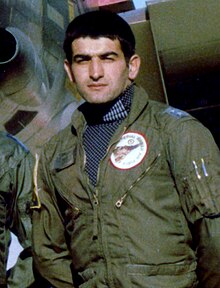Abbas Babaei
Abbas Babaei | |
|---|---|
 | |
| Born | 5 December 1950 Qazvin, Iran |
| Died | 6 August 1987 (aged 36) Sardasht, Iran |
| Buried | Qazvin, Iran |
| Allegiance | Iran |
| Service/ | Air Force |
| Years of service | 1969–1987 |
| Rank | Brigadier general |
| Battles/wars | Iran–Iraq War † |
| Awards | 2nd grade Fath Medal[1] |
Abbas Babaei (Persian: عباس بابایی) (5 December 1950 – 6 August 1987) was an Iranian pilot and brigadier-general in the Islamic Republic of Iran Air Force (IRIAF), during the Iran-Iraq War.
Education[edit]
He was born in a middle class religious family in Qazvin in 1950. Babaei was a student at Dehkhoda primary school and graduated from Nezam Vafa high school. After graduating in 1969 he moved to the United States to become a fighter pilot. During his studies in the U.S. he was chosen as the volleyball captain of the airbase volleyball team.[2]
Return to Iran[edit]
After returning to Iran following flight training, he became a pilot on the Northrop F-5 fighter aircraft. After returning to Iran he married his cousin Maliheh and moved to Dezful in Khuzestan Province where he resided in the Iranian Air Force residence. He had three children, a daughter, Salma, and two sons, Hossein and Mohammad.[2]
The Iran-Iraq war[edit]
He became the commander of the 8th Tactical Air Base in 1981. Aviation journalist and Iran-Iraq air war expert Tom Cooper reports that Babaei was "notorious for his merciless treatment of the pilots and officers" considered disloyal to the new regime.[3] Cooper's research indicates:
- ... Col. Abbas Baba’ie, an officer differently described as the "mastermind of IRIAF’s capability to keep its F-14-fleet intact", or simply a "war hero". There are, however, numerous former IRIAF pilots who not only deny that Baba’ie ever even qualified on F-14s, but also outright refuse to even mention his name, most likely because of his close cooperation with the clerical regime in Tehran.[4]
Death[edit]

General Abbas Babaei was killed on 6 August 1987, while in the rear seat of an F-5B while over Iraqi air space. He was hit by a 23 mm round of an air defense system on Sardasht air space, a city located in west Azerbaijan, Iran. It turned out an Iranian' defense system, operated by Sepah, had hit Babaei's aircraft in error. The pilot, Major Ali Mohammad Naderi managed to land the jet, but Babaei died within 10 minutes. Sepah used the ZSU-23 self-propelled, radar guided anti-aircraft weapon system (SPAAG) at the time.[5]
In 2011, Flying Passion was shown on Channel 1. The film was about Babaei's lifetime.
The memory of Babayi, who earned shahid ("martyr") status for his untimely death,[6] is preserved in the name of Shahid Babaee High School (Qazvin Sampad), his commemorative statute in Qazvin (shown at right), and in Tehran's Babayi Expressway.
References[edit]
- ^ Poursafa, Mahdi (20 January 2014). گزارش فارس از تاریخچه نشانهای نظامی ایران، از «اقدس» تا «فتح»؛ مدالهایی که بر سینه سرداران ایرانی نشسته است [From "Aghdas" to "Fath": Medals resting on the chest of Iranian Serdars]. Fars News (in Persian). Archived from the original on 21 January 2014. Retrieved 21 October 2014.
- ^ a b "martyr abbas babaee". Babaee en Sahid. Archived from the original on 13 October 2013. Retrieved 5 July 2013.
- ^ Iranian F-14 Tomcat Units in Combat by Tom Cooper & Farzad Bishop, 2004, Oxford: Osprey Publishing, p. 23, ISBN 1 84176 787 5
- ^ "Fire in the Hills: Iranian and Iraqi Battles of Autumn 1982 By Tom Cooper & Farzad Bishop, 9 September 2003". Archived from the original on 22 August 2014. Retrieved 17 March 2014.
- ^ "Chronological Listing of Iranian Air Force Northrop F-5: Losses & Ejections". Archived from the original on 3 November 2013. Retrieved 17 March 2014.
- ^ "In Memory of IRIAF Pilot Brg. Gen. Abbas Babaie (Part 1)". YouTube (in Persian). 19 November 2010.
